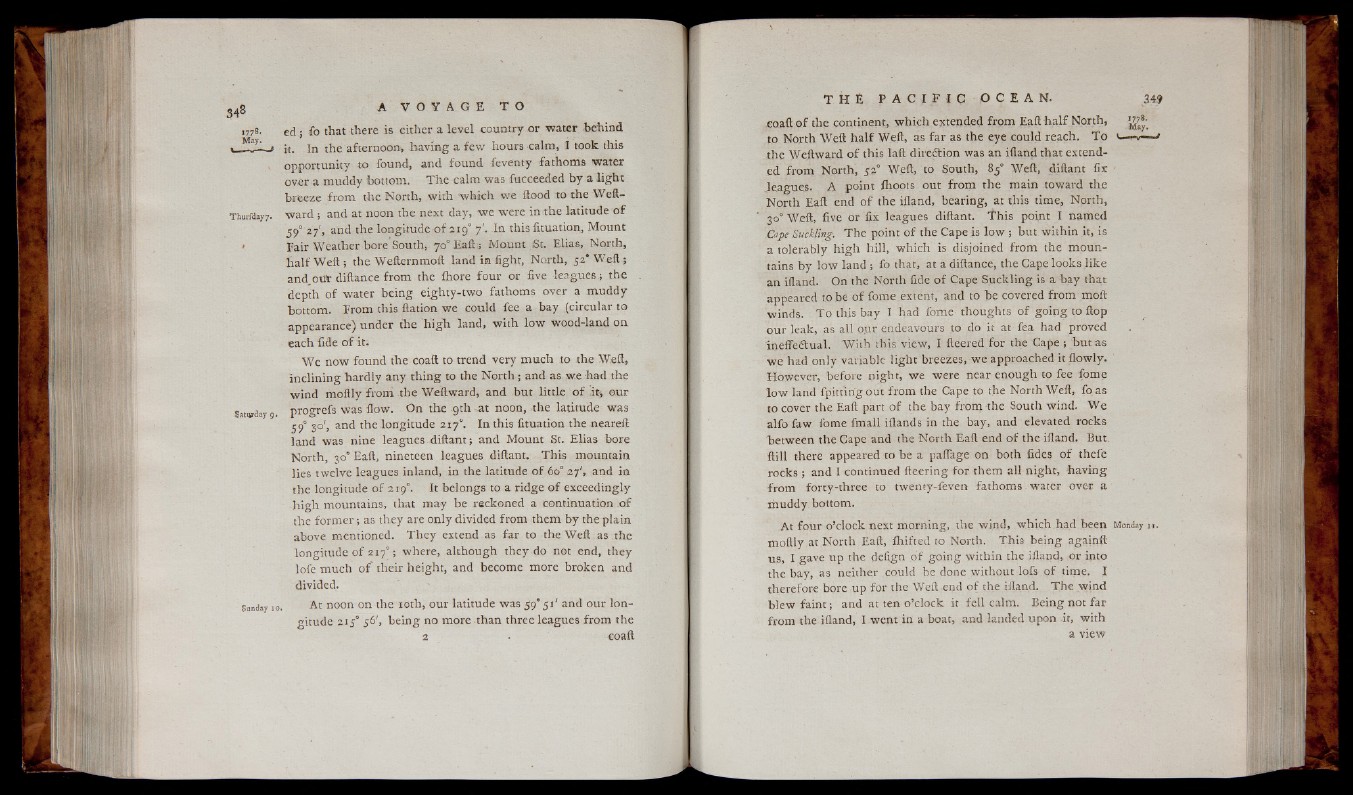
1778. ed ; fo that there is either a lev e l country or water behind
v a - « jt, in the afternoon* ha vin g a few hours calm, I took this
opportunity to found, and found feventy fathoms water
over a muddy 'bottom. T h e calm was fucceeded by a lig h t
breeze from the North, with w h ich we flood to the Weft-
Thurfday7. ward ; and at noon the next day, w e were in the latitude o f
590 27', and the longitude o f 219° 7 1. In this flotation, Mount
' Fair Weather bore South, 70° Eaft;; Mount St. Elias, North,
h a lf Weft ; the Wefternmoft land in fight, North, 52* Weft ;
and ouv diftance from the fliore four or five leagues.; the
depth o f water being e ighty-two fathoms over a muddy
bottom. From this ftation we could fee a bay (circular to
appearance) under the h ig h land, w ith low wood-land on
each fide o f it;
We now found the coaft to trend very much to the Weft,
in clinin g hardly any thing to the North ; and as we had the
wind moftly from the Weftward, and but little o f it , our
Saturday 9. progrefs was flow. On the .9th at noon, the latitude was
590 30', and the longitude 217°. In this fituatian the neareft
land was nine leagues diftant; and Mount St. Elias bore
North, 30° Eaft, nineteen leagues diftant. This mountain
lies twelve leagues inland, in the latitude o f 6o° 27', and in
the longitude o f 219°. It belongs to a ridge o f exceedingly
h ig h mountains, that may be reckoned a continuation :of
the former ; as they are only divided from them by the plain
above mentioned. T h e y extend as far to the Weft as the
longitude o f 217° ; where, although they do not end, they
lofe much of' their height, and become more broken and
divided.
Sunday 10. At noon on the 10th, our latitude was ¿9*51' and our longitude
215° 56', being no more than three leagues from the
2 • coaft
coaft o f the continent, w hich extended from Eaft h a lf North,
to North Weft h a l f Weft, as fa r as the eye could reach. T o
the Weftward o f this laft direftion was an ifland that extended
from North, 52° Weft, to South, 85° Weft, diftant fix
leagues. A point ihoots out from the main toward the
North Eaft end o f the ifland, bearing, at this time, North,
30° Weft, five or fix leagues diftant. "this point I named
.Cape Suckling. The point o f the Cape is low ; but within it, is
a tolerably h ig h hill, which is disjoined from the mountains
b y low land ; fo that, at a diftance, the Cape looks like
an ifland. On the North fide o f Cape S u ckling is a bay that
appeared to be o f fome extent, and to be covered from moll
winds. T o this bay I had fome thoughts o f g o in g to flop
our leak, as all our endeavours to do it at fea had proved
ineffectual. With this view, I fleered for the Cape ; but as
w e had only variable ligh t breezes, we approached it flowly.
However, before n ight, w e were near enough to fee fome
low land fpittirig out from the Cape to the North Weft, fo as
to cover the Eaft part o f the bay fron> the South wind. W e
alfo faw fome fmall iflands in the bay, and elevated rocks
between the Cape and the North Eaft end o f the ifland. But.
ftill there appeared to be a paflage on both fides o f thefe
rocks ; and I continued fleering for them all night, ha vin g
from forty-three to twenty-feven fathoms water over a
muddy bottom.
At four o’clock next morning, the wind, which had been Monday h .
moftly at North Eaft, fliifted to North. T h is being againft
us, I gave up the defign o f go in g within the ifland, or into
the bay, as neither could be done without lofs o f time. I
therefore bore up for the Weft end o f the ifland. T h e wind
blew fain t; and at ten o ’clock it fe ll calm. Being not far
from the ifland, I went in a boat, and landed upon it, with
a view